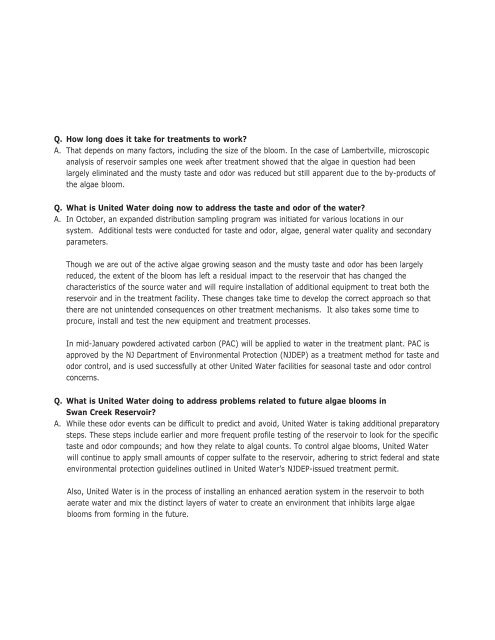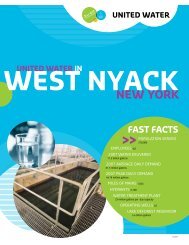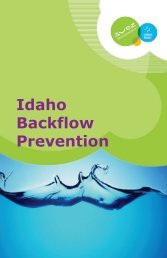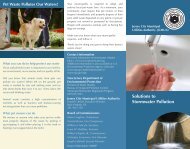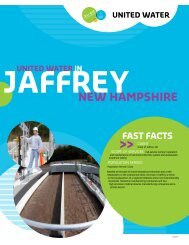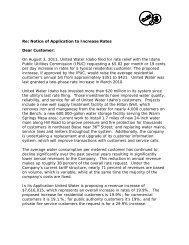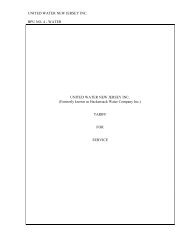United Water Lambertville Taste and Odor Q and A
United Water Lambertville Taste and Odor Q and A
United Water Lambertville Taste and Odor Q and A
You also want an ePaper? Increase the reach of your titles
YUMPU automatically turns print PDFs into web optimized ePapers that Google loves.
Q. How long does it take for treatments to work?<br />
A. That depends on many factors, including the size of the bloom. In the case of <strong>Lambertville</strong>, microscopic<br />
analysis of reservoir samples one week after treatment showed that the algae in question had been<br />
largely eliminated <strong>and</strong> the musty taste <strong>and</strong> odor was reduced but still apparent due to the by-products of<br />
the algae bloom.<br />
Q. What is <strong>United</strong> <strong>Water</strong> doing now to address the taste <strong>and</strong> odor of the water?<br />
A. In October, an exp<strong>and</strong>ed distribution sampling program was initiated for various locations in our<br />
system. Additional tests were conducted for taste <strong>and</strong> odor, algae, general water quality <strong>and</strong> secondary<br />
parameters.<br />
Though we are out of the active algae growing season <strong>and</strong> the musty taste <strong>and</strong> odor has been largely<br />
reduced, the extent of the bloom has left a residual impact to the reservoir that has changed the<br />
characteristics of the source water <strong>and</strong> will require installation of additional equipment to treat both the<br />
reservoir <strong>and</strong> in the treatment facility. These changes take time to develop the correct approach so that<br />
there are not unintended consequences on other treatment mechanisms. It also takes some time to<br />
procure, install <strong>and</strong> test the new equipment <strong>and</strong> treatment processes.<br />
In mid-January powdered activated carbon (PAC) will be applied to water in the treatment plant. PAC is<br />
approved by the NJ Department of Environmental Protection (NJDEP) as a treatment method for taste <strong>and</strong><br />
odor control, <strong>and</strong> is used successfully at other <strong>United</strong> <strong>Water</strong> facilities for seasonal taste <strong>and</strong> odor control<br />
concerns.<br />
Q. What is <strong>United</strong> <strong>Water</strong> doing to address problems related to future algae blooms in<br />
Swan Creek Reservoir?<br />
A. While these odor events can be difficult to predict <strong>and</strong> avoid, <strong>United</strong> <strong>Water</strong> is taking additional preparatory<br />
steps. These steps include earlier <strong>and</strong> more frequent profile testing of the reservoir to look for the specific<br />
taste <strong>and</strong> odor compounds; <strong>and</strong> how they relate to algal counts. To control algae blooms, <strong>United</strong> <strong>Water</strong><br />
will continue to apply small amounts of copper sulfate to the reservoir, adhering to strict federal <strong>and</strong> state<br />
environmental protection guidelines outlined in <strong>United</strong> <strong>Water</strong>’s NJDEP-issued treatment permit.<br />
Also, <strong>United</strong> <strong>Water</strong> is in the process of installing an enhanced aeration system in the reservoir to both<br />
aerate water <strong>and</strong> mix the distinct layers of water to create an environment that inhibits large algae<br />
blooms from forming in the future.


